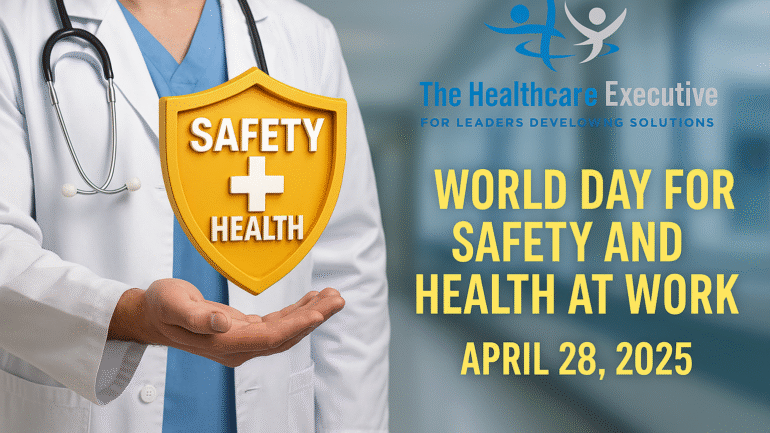World Day for Safety and Health at Work – April 28, 2025

- Posted by Greg Wahlstrom, MBA, HCM
- Posted in Health Observance Calendar
Prioritizing Protection: Executive Leadership on Workplace Safety
Published: April 28, 2025
Every April 28, the World Day for Safety and Health at Work reminds organizations globally that workplace safety is more than compliance—it’s culture. In healthcare, that culture begins at the top. Executive leadership must not only champion personal protective equipment (PPE) policies, but also establish systemic protocols that protect clinicians, patients, and facility teams. According to the International Labour Organization (ILO), over 2.9 million people die annually from work-related illnesses or accidents. In hospital settings, the stakes are even higher, with exposure to infectious disease, stress, lifting injuries, and violence posing daily threats. At institutions like BayCare Health System, boards have established Safety Councils reporting directly to the C-suite. These councils help align enterprise risk with staff well-being and create accountability beyond incident response. Safety is no longer reactive—it must be operationalized. This operational shift requires executive-level prioritization and funding.
Workplace safety must also be integrated into the broader fabric of hospital governance. Forward-thinking systems are weaving safety KPIs into board scorecards and strategic planning. For instance, Mercy Health includes near-miss reporting rates and safety climate surveys in its CEO dashboards. By elevating these metrics to the highest level, leaders send a clear message: protecting staff is a strategic imperative. Beyond metrics, executives should invest in ergonomic design, trauma-informed de-escalation training, and continuous environmental risk assessments. Hospitals are complex, high-risk environments, and meaningful change comes from top-down modeling of best practices. This includes leaders physically rounding to assess hazards and listening directly to frontline voices. Executives set the tone for accountability, transparency, and continuous improvement. Inaction, on the other hand, signals misalignment between values and outcomes. Leadership that protects is leadership that earns trust.
In 2025, workplace safety is also a matter of digital modernization. With wearable devices, AI-driven risk detection, and automated compliance reporting, health systems are advancing safety with technology. Leaders at Northwell Health are piloting real-time fatigue monitors for surgical teams, combining clinical outcomes with worker safety. Systems like these not only reduce injuries—they also reduce burnout and improve retention. As workforce shortages continue, protecting staff must be viewed as an investment, not a cost. The Healthcare Executive urges board members and C-level leaders to adopt tech-backed safety dashboards and predictive analytics to anticipate and prevent harm. Digital integration should include incident heatmaps, cleaning cycle logs, and occupational health flags. It’s time to shift safety from clipboard audits to dynamic, executive-level intelligence. Technology alone won’t save lives—but leaders who leverage it strategically will.
Equity must also be embedded in workplace safety strategy. The risks faced by healthcare workers are not evenly distributed. Lower-wage roles, such as environmental services and nursing assistants, disproportionately bear the burden of physical risk. Systems like Sutter Health are addressing this by offering multilingual safety training, union-supported PPE design input, and inclusive safety committees. Equity in safety means recognizing that everyone deserves the same protection, regardless of role or status. Executives must ensure that safety infrastructure serves all departments equally—clinical and non-clinical alike. Prioritizing equity in environmental safety reinforces both retention and organizational ethics. Hospital leadership that values every worker’s well-being strengthens organizational resilience. True safety is inclusive, data-informed, and built into the culture—not just policy binders.
As we observe World Day for Safety and Health at Work, hospital executives must step forward as chief protectors of the workforce. This is not the role of compliance officers alone. It is a leadership responsibility that demands vision, funding, and sustained cultural change. Establishing zero-harm goals, backing staff safety champions, and using data to drive transparency will elevate organizations as leaders in health equity and safety. Staff will remember the systems that protected them. Patients will trust those who prioritize both outcomes and those who deliver them. And the industry will shift—from reactive safety to proactive, people-first leadership. Safety isn’t a department—it’s a duty.
Discover More:
Explore how executive leaders are turning workplace safety into strategy and impact across healthcare systems.
Internal Links
- World Tuberculosis Day 2025: Leadership in Disease Elimination
- National Drug and Alcohol Facts Week 2025
- Black Maternal Health Week 2025: Advancing Equity in Care



